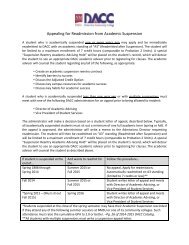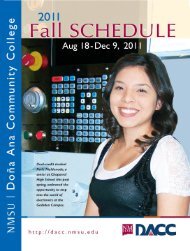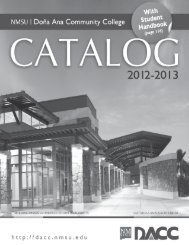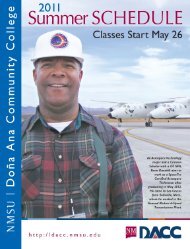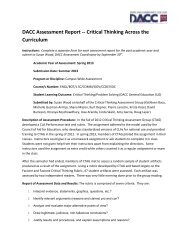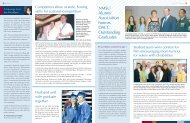online - Dona Ana Community College - New Mexico State University
online - Dona Ana Community College - New Mexico State University
online - Dona Ana Community College - New Mexico State University
Create successful ePaper yourself
Turn your PDF publications into a flip-book with our unique Google optimized e-Paper software.
Students may choose one of two options: Electronics<br />
Technology or Aerospace Technology. Within the Electronics<br />
Technology Option, there are two further specializations:<br />
the Biomedical Electronics Track and the General Electronics<br />
Track.<br />
ELECTRONICS TECHNOLOGY OPTION (43 CREDITS)<br />
OECS 227 Computer Applications for Technicians (3)<br />
OEES 135 Electronics II (4)<br />
OEES 155 Electronic CAD and PCB Design (3)<br />
OEES 160 Digital Electronics I (4)<br />
OEES 175 Soldering Practices (2)<br />
OEES 205 Semiconductor Devices (4)<br />
OEES 215 Microprocessor Systems I (4)<br />
OR OEMG 235 Programmable Logic Controllers<br />
Pneumatics<br />
OEMG 240 Electromechanical Devices (4)<br />
OR OEES 260 Instrumentation Control and Signal<br />
Conditioning<br />
OEES 250 Electronics Systems <strong>Ana</strong>lysis (2)<br />
Choose one of the following tracks: (13–14)<br />
BIOMEDICAL ELECTRONICS TRACK (14)<br />
OEES 270 Biomedical Equipment Instrumentation (4)<br />
OEHO 120 Medical Terminology (3)<br />
OEHO 140 Essentials of <strong>Ana</strong>tomy and Physiology (4)<br />
OEHO 202 Legal and Ethical Issues in Health Care (3)<br />
GENERAL ELECTRONICS TRACK (13)<br />
OEES 220 Electronic Communications Systems (4)<br />
OEES 230 Microprocessor Systems II (4)<br />
OR OEMG 245 Electromechanical Systems (3)<br />
OEES 235 Digital Electronics II (3)<br />
OR OEMG 265 Special Topics:<br />
System Interface Devices (3)<br />
OEES 240 Introduction to Photonics (3)<br />
AEROSPACE TECHNOLOGY OPTION (43)<br />
OEES 105 Basic Electricity and Electronics (3)<br />
OEMG 105 Intro. to Manufacturing (2)<br />
OEMG 115 Print Reading for Industry (3)<br />
OEMG 240 Electromechanical Devices (4)<br />
OEMG 245 Electromechanical Systems (3)<br />
SPCT 114 Applied Manufacturing Practices (3)<br />
SPCT 115 Machine Operation and Safety (3)<br />
SPCT 121 Introduction to the Aerospace<br />
Workplace (3)<br />
SPCT 122 Aerospace Safety and Quality (3)<br />
OEMG 265 Special Topics: Aerospace Fluid Systems (3)<br />
OEMG 265 Special Topics: Aerospace Systems (3)<br />
OEMG 265 Special Topics: Inspection and<br />
Planning (Metrology) (3)<br />
OEMG 265 Special Topics: Aerospace Tests and<br />
Measurements (3)<br />
OETS 190 Physics for Aerospace Technicians (4)<br />
OEWT 120 Basic Metallurgy (3)<br />
Certificate (30 credits)<br />
Core Education Requirement<br />
4 credits<br />
ENGL 111G Rhetoric and Composition 4<br />
Technical Requirements<br />
26 credits<br />
OEES 110 Electronics I 4<br />
OEES 120 Mathematics for Electronics 4<br />
OEES 135 Electronics II 4<br />
OEES 155 Electronic CAD and PCB Design 3<br />
OEES 160 Digital Electronics I 4<br />
OEES approved electives 7<br />
Emergency Medical<br />
Services<br />
Preparation for EMT—Basic Licensure<br />
Preparation for EMT–Intermediate Licensure<br />
Paramedic Certificate<br />
Associate of Applied Science Degree<br />
527-7645<br />
Prehospital emergency medical care is a challenging and exciting<br />
profession. People’s lives often depend on the quick reaction and<br />
competent care of emergency medical technicians (EMTs) and paramedics.<br />
Emergency medical services (EMS) professionals may work at any of<br />
four different levels: first responder, EMT–basic, EMT–intermediate,<br />
and paramedic. Upon successful completion of training, students<br />
are eligible for employment in many types of emergency medical<br />
systems nationwide—in fire departments, municipal services, private<br />
ambulance services, federal services, industry, hospital emergency<br />
departments, and hospital-based ambulance systems. The<br />
demand for EMS professionals is increasing.<br />
DACC offers all levels of EMS education, as well as an opportunity<br />
to earn an associate of applied science degree at the paramedic<br />
level. Successful completion of an EMS program will allow for<br />
certification/licensure testing at the state and national level. The<br />
Emergency Medical Services program is nationally accredited by<br />
the Committee on Accreditation on Education for the EMS Professions<br />
and approved by the <strong>New</strong> <strong>Mexico</strong> Office of Health Emergency<br />
Management.<br />
At each EMS program level, students gain additional knowledge and<br />
skills to enable them to function in the clinical and field settings with<br />
nurses, physicians, and other healthcare professionals. In classes,<br />
students learn about anatomy and physiology, the pathophysiology<br />
of diseases, traumatic injuries, pharmacology, and cardiac care. Students<br />
acquire skills through laboratory practice, clinical experience<br />
in hospitals, and field experience with ambulance services throughout<br />
the state. Students may be scheduled at a variety of clinical and<br />
field sites which include areas outside Las Cruces.<br />
EMS Entrance Requirements<br />
Specific entrance requirements and prerequisites vary depending on<br />
the qualifications of the applicant and the level of training/licensure<br />
sought:<br />
EMT–Basic: No prerequisites<br />
EMT–Intermediate:<br />
• Successful completion of EMT–Basic coursework<br />
• EMT–Basic license in hand prior to admission, or by end of<br />
sixth week of EMT–Intermediate program<br />
• Score of no less than 80 percent on departmental exams<br />
2 0 0 7 - 2 0 0 8 C A TA L O G<br />
45



